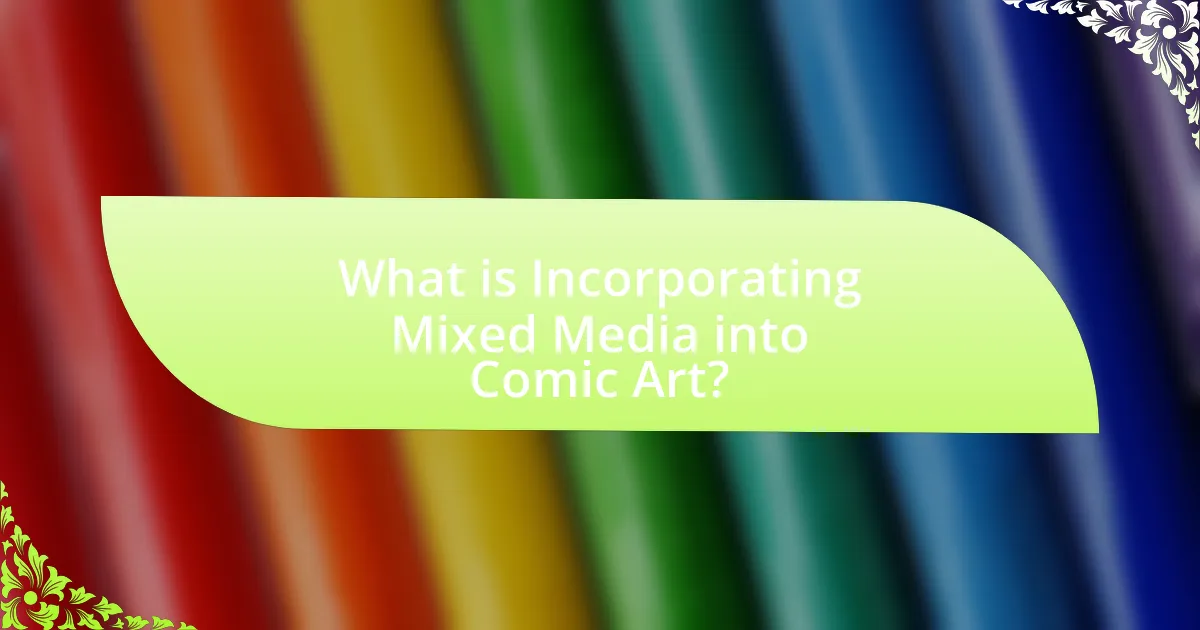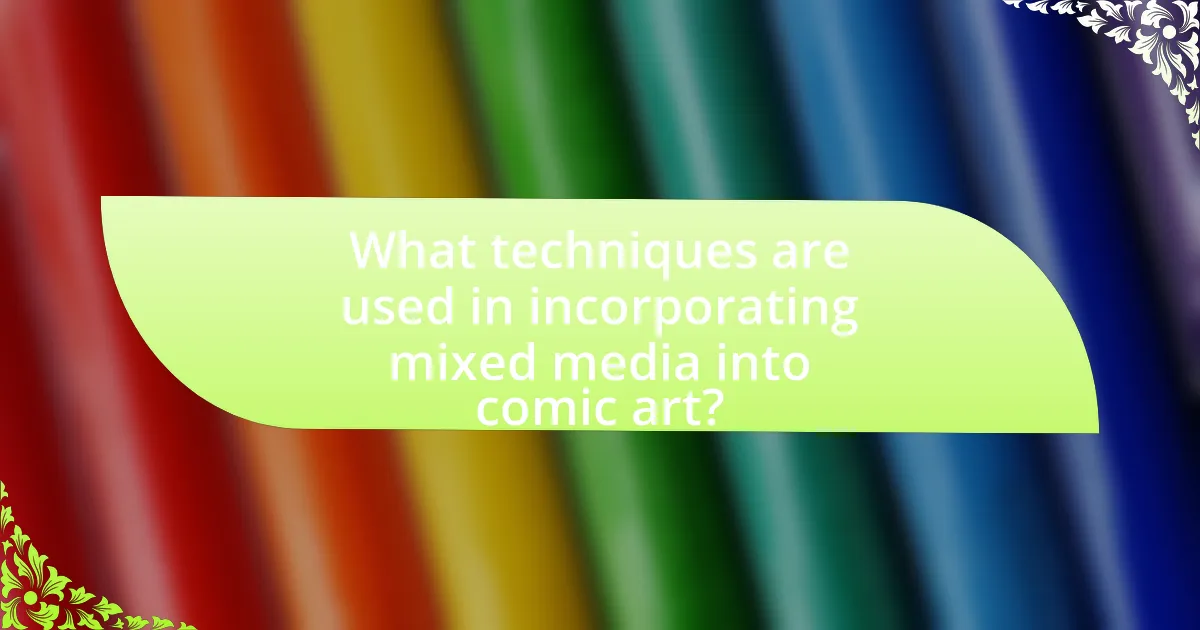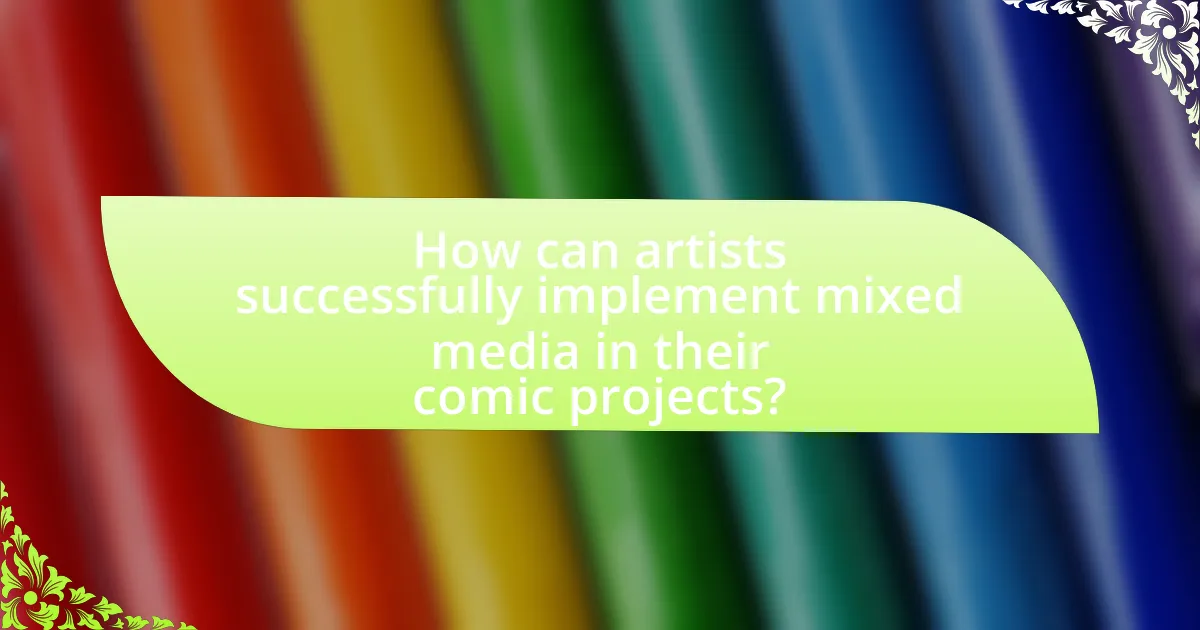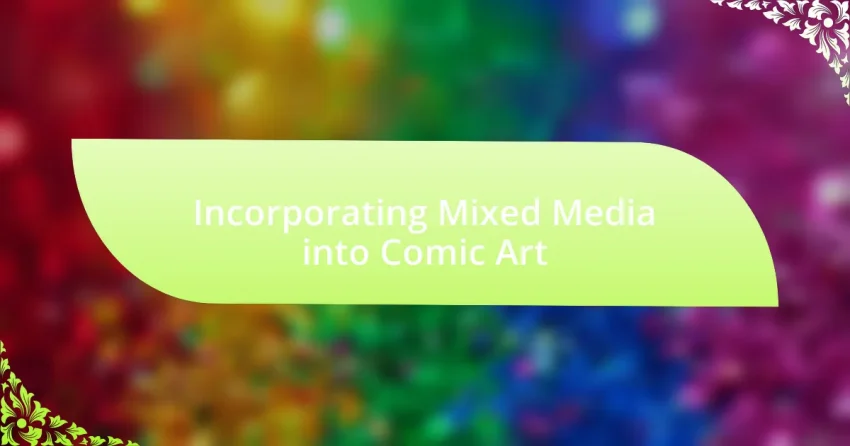Incorporating mixed media into comic art involves the integration of various artistic materials and techniques, such as paint, collage, digital elements, and photography, to enhance visual storytelling. This approach allows artists to create diverse textures and layers, enriching the narrative experience and engaging readers on multiple levels. Key techniques include collage, digital manipulation, and traditional painting, which can be combined to produce unique visual styles. The article also explores the importance of mixed media in contemporary comic art, emerging trends, and the challenges artists face, while providing practical steps for effectively implementing mixed media in comic projects.

What is Incorporating Mixed Media into Comic Art?
Incorporating mixed media into comic art involves the integration of various artistic materials and techniques beyond traditional ink and paper, such as paint, collage, digital elements, and photography. This approach enhances visual storytelling by allowing artists to create diverse textures and layers, thereby enriching the narrative experience. For instance, artists like David Mack and Scott McCloud have utilized mixed media to push the boundaries of comic art, demonstrating how combining different mediums can lead to innovative visual expressions and deeper emotional engagement in storytelling.
How does mixed media enhance comic art?
Mixed media enhances comic art by allowing artists to combine various materials and techniques, resulting in richer visual narratives. This approach enables the integration of textures, colors, and styles that traditional methods may not achieve, thereby creating a more immersive experience for the reader. For instance, the use of collage, paint, and digital elements can evoke different emotions and highlight specific themes within the story. Historical examples, such as the works of artists like David Mack and his use of watercolor and ink, demonstrate how mixed media can elevate storytelling by adding depth and complexity to the artwork.
What are the different types of mixed media used in comic art?
Different types of mixed media used in comic art include traditional materials like ink, watercolor, and acrylics, as well as digital elements such as digital painting and photo manipulation. Traditional ink is often used for line work, while watercolor and acrylics provide color and texture. Digital painting allows for layering and effects that enhance visual storytelling, and photo manipulation can incorporate real-world images into the comic narrative. These various media types enable artists to create unique visual styles and effects, enriching the overall comic art experience.
How do various materials influence the visual storytelling in comics?
Various materials significantly influence visual storytelling in comics by altering texture, color, and depth, which enhances narrative engagement. For instance, traditional ink on paper creates a classic aesthetic that can evoke nostalgia, while digital tools allow for vibrant colors and effects that can convey mood and atmosphere more dynamically. Additionally, the use of mixed media, such as incorporating photographs or fabric, can add layers of meaning and texture that traditional methods cannot achieve, thereby enriching the storytelling experience. Research indicates that comics employing diverse materials can engage readers more effectively, as seen in works like “Fun Home” by Alison Bechdel, where the combination of different artistic techniques deepens emotional resonance and narrative complexity.
Why is mixed media important in contemporary comic art?
Mixed media is important in contemporary comic art because it enhances visual storytelling by combining various artistic techniques and materials. This approach allows artists to create more dynamic and engaging narratives, as seen in works by creators like David Mack and Julie Doucet, who utilize collage, painting, and digital elements to enrich their comics. The integration of mixed media not only broadens the aesthetic possibilities but also reflects the complexity of modern life, making the art form more relatable and impactful for diverse audiences.
What trends are emerging in the use of mixed media in comics?
Emerging trends in the use of mixed media in comics include the integration of digital elements, collage techniques, and the blending of traditional and contemporary art styles. Artists are increasingly utilizing digital tools to enhance their work, allowing for greater experimentation with textures and layers. For instance, the use of augmented reality (AR) is becoming more prevalent, enabling readers to interact with comic panels through their devices, thus creating a more immersive experience. Additionally, the incorporation of photography and found objects into comic art is gaining traction, as seen in works by artists like David Mack, who combines painting with photographic elements. This trend reflects a broader movement towards hybrid art forms, where boundaries between different mediums are increasingly blurred, allowing for innovative storytelling methods.
How does mixed media reflect cultural and social themes in comic art?
Mixed media in comic art reflects cultural and social themes by integrating diverse materials and techniques that convey complex narratives and emotions. This approach allows artists to blend traditional drawing with photography, collage, and digital elements, thereby enriching the storytelling experience. For instance, the use of newspaper clippings or fabric can evoke historical contexts or personal memories, making the artwork resonate with specific cultural identities. Additionally, comics like “Fun Home” by Alison Bechdel utilize mixed media to explore themes of sexuality and family dynamics, illustrating how varied artistic methods can deepen the exploration of social issues. Such integration not only enhances visual appeal but also invites viewers to engage with the underlying messages on multiple levels, demonstrating the power of mixed media in reflecting the intricacies of human experience.

What techniques are used in incorporating mixed media into comic art?
Techniques used in incorporating mixed media into comic art include collage, digital manipulation, and traditional painting combined with ink drawing. Collage involves layering various materials such as photographs, textured paper, and fabric to create depth and visual interest. Digital manipulation allows artists to blend traditional hand-drawn elements with digital graphics, enhancing colors and effects. Traditional painting techniques, such as watercolor or acrylic, can be integrated with ink drawings to produce unique textures and styles. These methods have been utilized by artists like David Mack and Scott McCloud, who demonstrate the effectiveness of mixed media in storytelling and visual expression within comics.
How can artists effectively combine different media in their comic work?
Artists can effectively combine different media in their comic work by strategically integrating traditional and digital techniques to enhance storytelling and visual impact. For instance, artists can use hand-drawn illustrations alongside digital elements, such as photo manipulation or digital painting, to create a unique aesthetic that captures the reader’s attention. This approach allows for greater flexibility in design and can convey complex narratives more effectively.
Moreover, the use of mixed media can include incorporating textures from physical materials, like fabric or paper, which can be scanned and layered digitally. This technique has been successfully employed by artists like David Mack in his comic “Kabuki,” where he blends watercolor, ink, and collage to create a rich visual experience. Such methods not only diversify the visual language of comics but also engage readers on multiple sensory levels, making the artwork more immersive.
What are the best practices for layering materials in comic art?
The best practices for layering materials in comic art include using a variety of textures and transparencies to create depth and interest. Artists should start with a solid base layer, typically using ink or pencil, and then build up with additional materials such as watercolor, markers, or digital elements. This approach allows for a dynamic interplay between different mediums, enhancing the visual narrative.
For instance, applying a wash of watercolor over ink can create a soft background that contrasts with sharper foreground elements, effectively guiding the viewer’s eye. Additionally, artists should consider the drying times and compatibility of materials; for example, oil-based products should not be layered over water-based ones to avoid smudging or lifting.
Research indicates that layering techniques can significantly impact the overall aesthetic and storytelling in comic art, as seen in works by artists like Dave McKean, who effectively combines photography, painting, and digital manipulation to create unique visual experiences.
How do artists choose the right media for their comic narratives?
Artists choose the right media for their comic narratives by considering the story’s tone, audience, and visual style. The selection process involves evaluating how different media can enhance the narrative’s emotional impact and clarity. For instance, traditional ink and watercolor may evoke a classic feel, while digital tools can offer versatility and precision. Research indicates that the choice of media significantly influences reader engagement and interpretation, as seen in studies analyzing the effects of visual styles on storytelling effectiveness.
What challenges do artists face when using mixed media in comics?
Artists face several challenges when using mixed media in comics, primarily related to consistency, material compatibility, and production complexity. Consistency is crucial, as varying techniques and materials can lead to a disjointed visual narrative, making it difficult for readers to engage with the story. Material compatibility poses another challenge; different media may not adhere well to one another, leading to issues such as smudging or deterioration over time. Additionally, the production complexity increases, as artists must navigate the logistics of combining various materials, which can complicate the printing process and affect the final output quality. These challenges necessitate careful planning and experimentation to achieve a cohesive and visually appealing comic.
How can artists overcome common technical difficulties with mixed media?
Artists can overcome common technical difficulties with mixed media by experimenting with various materials and techniques to find compatible combinations. For instance, understanding the properties of different media, such as how water-based paints interact with oil-based materials, allows artists to avoid issues like smudging or bleeding. Additionally, utilizing layering techniques can help manage the drying times and adhesion properties of different materials, ensuring that each layer adheres properly without compromising the overall composition. Research indicates that artists who engage in systematic experimentation and documentation of their processes are more likely to develop effective strategies for overcoming these challenges, as seen in studies on creative practices in visual arts.
What are the potential pitfalls of using mixed media in comic art?
The potential pitfalls of using mixed media in comic art include inconsistency in style, difficulty in reproduction, and challenges in maintaining narrative clarity. Inconsistency arises when different media create varying visual effects, which can disrupt the overall aesthetic and coherence of the comic. Difficulty in reproduction occurs because certain mixed media elements, such as textures or three-dimensional objects, may not translate well to print or digital formats, leading to loss of detail or fidelity. Additionally, challenges in maintaining narrative clarity can emerge when the integration of diverse media distracts from the story, making it harder for readers to follow the plot. These pitfalls highlight the need for careful planning and execution when incorporating mixed media into comic art.

How can artists successfully implement mixed media in their comic projects?
Artists can successfully implement mixed media in their comic projects by combining various artistic techniques and materials to enhance storytelling and visual impact. This approach allows for the integration of traditional drawing, painting, and digital elements, creating a unique aesthetic that engages readers. For instance, using collage techniques with paper cutouts alongside digital illustrations can add depth and texture to the artwork. Additionally, artists can experiment with different mediums, such as watercolor, ink, and photography, to create diverse visual narratives. The effectiveness of mixed media in comics is supported by examples from renowned artists like David Mack, who utilizes watercolor and ink in his series “Kabuki,” demonstrating how varied techniques can elevate the comic art form.
What are some tips for beginners in mixed media comic art?
Beginners in mixed media comic art should start by experimenting with various materials such as ink, watercolor, and collage elements to discover their unique style. This approach allows artists to combine different textures and techniques, enhancing visual storytelling. For instance, using watercolor for backgrounds can create depth, while ink can define characters and outlines. Additionally, beginners should practice layering techniques, as this can add complexity and interest to their artwork. Engaging with online tutorials and communities can provide valuable feedback and inspiration, further aiding skill development.
How can artists develop their unique style using mixed media?
Artists can develop their unique style using mixed media by experimenting with various materials and techniques to create distinctive visual effects. This approach allows artists to combine traditional mediums like ink and watercolor with unconventional materials such as fabric, found objects, or digital elements, fostering innovation and personal expression. For instance, the integration of collage techniques can introduce texture and depth, while layering different mediums can enhance narrative complexity in comic art. Historical examples, such as the works of Robert Rauschenberg, demonstrate how mixed media can break boundaries and lead to a signature style that resonates with audiences.
What resources are available for learning mixed media techniques in comics?
Resources for learning mixed media techniques in comics include online courses, books, and workshops. Online platforms like Skillshare and Udemy offer specific courses on mixed media art tailored for comic creation, providing structured lessons and practical exercises. Books such as “Mixed Media Techniques for Artists” by Kira K. and “Comics and Sequential Art” by Will Eisner serve as comprehensive guides, detailing various techniques and applications in comic art. Additionally, local art schools and community centers often host workshops that focus on mixed media, allowing for hands-on experience and direct feedback from instructors. These resources collectively support artists in mastering mixed media techniques within the comic art form.
What are the future prospects for mixed media in comic art?
The future prospects for mixed media in comic art are promising, as artists increasingly explore innovative techniques that blend traditional and digital methods. This evolution is driven by advancements in technology, such as augmented reality and digital printing, which allow for more dynamic storytelling and interactive experiences. For instance, the rise of webcomics and platforms like Tapas and Webtoon has facilitated the integration of multimedia elements, enabling creators to reach wider audiences and experiment with formats that combine animation, sound, and interactivity. Additionally, the growing acceptance of mixed media in mainstream comic publications, as seen in works like “The Sandman: Overture” by Neil Gaiman, showcases the potential for diverse artistic expressions. This trend indicates that mixed media will continue to expand the boundaries of comic art, fostering creativity and engagement in the medium.
How might technology influence the evolution of mixed media in comics?
Technology significantly influences the evolution of mixed media in comics by enabling creators to blend various artistic forms and techniques seamlessly. Digital tools such as graphic design software, animation programs, and augmented reality applications allow artists to integrate traditional drawing with photography, video, and interactive elements. For instance, the rise of digital platforms has led to the creation of webcomics that incorporate animated sequences and sound, enhancing storytelling and reader engagement. Additionally, advancements in printing technology have made it easier to produce high-quality, mixed media works that combine different materials and textures, further expanding the creative possibilities in comic art.
What role will mixed media play in the next generation of comic artists?
Mixed media will play a transformative role in the next generation of comic artists by enhancing storytelling and visual expression. This approach allows artists to combine traditional techniques, such as drawing and painting, with digital elements, photography, and collage, creating a richer narrative experience. For instance, the integration of augmented reality (AR) in comics has already begun to engage readers in interactive ways, as seen in projects like “The Walking Dead: The Official Cookbook and Survival Guide,” which incorporates QR codes linking to video content. This evolution reflects a broader trend in visual arts where hybrid forms are increasingly valued, as evidenced by the rise of artists who blend various media to push creative boundaries.
What practical steps can artists take to start incorporating mixed media into their comic art?
Artists can start incorporating mixed media into their comic art by experimenting with various materials and techniques. They should begin by selecting a combination of traditional and non-traditional materials, such as ink, watercolor, collage elements, and digital tools. This approach allows for diverse textures and visual effects that enhance storytelling.
Next, artists can create a mixed media sketchbook to test different combinations and styles without the pressure of a final product. This practice encourages exploration and innovation. Additionally, they should study existing mixed media comic artists to understand how they blend techniques effectively, which can provide inspiration and practical insights.
Finally, artists can participate in workshops or online courses focused on mixed media techniques, which can offer structured guidance and feedback. Engaging with a community of mixed media artists can also foster collaboration and idea exchange, further enriching their comic art practice.
